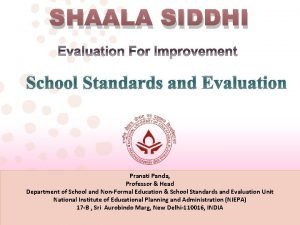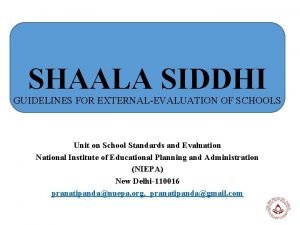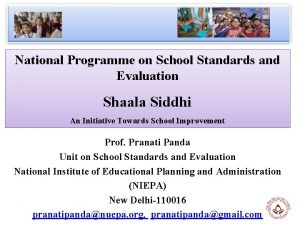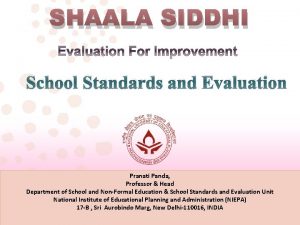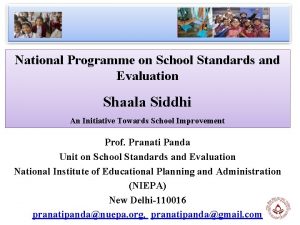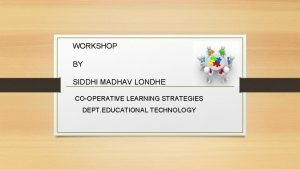SHAALA SIDDHI GUIDELINES FOR EXTERNALEVALUATION OF SCHOOLS Unit















- Slides: 15

SHAALA SIDDHI GUIDELINES FOR EXTERNAL-EVALUATION OF SCHOOLS Unit on School Standards and Evaluation National Institute of Educational Planning and Administration (NIEPA) New Delhi-110016 pranatipanda@nuepa. org, pranatipanda@gmail. com

External-Evaluation: A Collaborative Approach Towards School Improvement § External-Evaluation of the schools is considered as complementary to the self-evaluation process. § Follows as a corollary to self-evaluation so as to ensure that the two approaches work in synergy. § Collaborative external-evaluation process aims to bring transparency, accuracy and builds a better understanding of the overall school improvement process.

Objectives § To review school performance to validate, complement and supplement the School Self-Evaluation, thereby helping the school to identify its strengths and areas for improvement; § To support the school to identify its prioritization for incremental improvement of the school performance; § To highlight innovative, creative and best practices of the school; § To facilitate the school to develop an action plan and support towards improvement in an incremental and sustainable manner.

Constitution of the Team § External-Evaluators are external to the school, but internal to the education system. § They are responsible for external-evaluation of the schools, extending continuous support for improvement of the school and learners’ performance. § The team will be constituted by highest level officials at the state/district levels with specific orders to be issued at all the appropriate levels

External-Evaluation of Schools I. III. IV. V. Preparatory Phase Pre-Evaluation Phase Post Evaluation and Report Submission Ethical Standards

External Evaluation: Preparatory Phase Sl. No. Activities 1 Selection of external evaluators; decide a list of skills, experience, qualification and availability 2 Constitution of team; number of members based on the school size (two-five members), proportionate numbers of academics with school education background such as HMs, DIET faculty, and administrators like DEO, BEO etc. Formulate rules, regulations for performing their responsibilities and other administrative arrangements on boarding, lodging, DA, duty leave, travel, payment norms etc. Responsible stakeholders Shaala Siddhi Core Committee along with Nodal Officers At district level including identification of the evaluation team leader DEO based on the state guidelines

External Evaluation: Preparatory Phase (Cont. ) Sl. No. Activities 3 Orientation of external evaluators (design and content of orientation is shared in a separate document). This is to help develop desired attitudes, skills and competencies including methods of gathering evidences using research methods and protocols. 4 Delegation of responsibility 5 Agreement on sample; teachers, students, observation of classes, community members in school specific context. Responsible stakeholders Training agency or team identified by the state Team leader in consultation with the evaluation team based on expertise and experience Team leader to decide with reference to context of the specific school to be evaluated by the respective team.

Duration § The External-Evaluation should be conducted for each school in every three years. Though school self -evaluation is an annual feature, yet, external-evaluation should be conducted once in three year cycle (either in year-1, year-2, year-3) for each school. § External-evaluation may be conducted over a period of one academic year; where, one third of the targeted total number of schools at each block level will be covered; § It may be initiated from one week to two month’s time succeeding the school self-evaluation. This would help to support the school’s self-evaluation results of the previous year. The time and date for external-evaluation may be mutually fixed with the school.

Process of External-Evaluation: I. Pre-Evaluation Phase Activities Developing an in-depth understanding of Shaala Siddhi by accessing on-line/ hard copies of ‘School Standards and Evaluation Framework’ and ‘Guidelines for Self and External. Evaluation’ Studying all available school self-evaluation dashboards by accessing online or hard copies. Setting dates for school evaluation in consultation with the schools Persons Responsible Nodal officers Nodal Officers /school to be evaluated District/ Block education officials/ External-evaluation team / School Sending to schools one week prior to external-evaluation with a External-Evaluation Team copy marked to the Nodal officer: 1. The evaluation schedule 2. One page write-up stating purpose and process of externalevaluation along with a request for organising interactions Sharing the list of documents/ evidences used for self- School evaluation and keeping the same ready

Process of External-Evaluation II. Evaluation Phase Activities Persons Responsible Pre-evaluation Briefing Meeting: Introductory meeting to External-Evaluation Team set the stage for External-Evaluation activities which and School follow Discussion on School Self-Evaluation Dashboards School and External. Evaluation Team Sharing evidences by the schools on seven key domains School and External(46 Core Standards) Evaluation Team Analysis and review of judgments (professional decisions) School and Externalmade by schools against each Core Standard along with Evaluation Team the evidences Learning walk of the school to substantiate the evidences External-Evaluation Team on school performance levels: Going round the school, observing classrooms, other facilities, interaction with teachers and students to develop a perspectives on school

Process of External-Evaluation II. Evaluation Phase (Cont. ) II. Evaluation Phase Activities Collecting additional evidence through observations of/ interactions with school head, teachers, staff, parents and students specifically focusing on key domains: methods like interview, classroom observations and focus group discussion can be used Collective and collaborative deliberations with school on ‘self and external-evaluation’ reports providing scope for clarifications and justifications based on evidences Evaluation of ‘School Development Plan’ with a view to put into perspective strategic prioritization against Core Standards, including timelines and further support needed. Prioritisation of areas of improvement and action taken by the school for change management Debriefing Meeting: Sharing of learning experiences with the schools in order to communicate their strengths and opportunities for improvement Persons Responsible External-Evaluation Team School and Evaluation Team External-

Process of External-Evaluation III. Post Evaluation and Report Submission Activities Persons Responsible Uploading of the External-Evaluation report on the School External-Evaluation team Evaluation Dashboard Discussion with school Looking backward and forward: 1. Revise recent year’s School self-evaluation report School, SMC and External. Evaluation Team 2. Support schools in prioritized areas for effective implementation of School Improvement/ Development Plan. Follow-up and Monitoring: Periodic follow-up (every six- School and months) with the school on the status of implementation of the Evaluation Team School Improvement Plan in various areas of school functioning, using a tracker for monitoring implementation. External-

Process of External-Evaluation IV. Revisiting Activities Persons Responsible Identification of gaps between self and Expert Team/ external-evaluation reports: To be done External- Evaluation beginning from the second cycle of team External-Evaluation.

Ethical Standards 1. Responsive and Inclusive Orientation- Evaluations should be responsive to stakeholders and their communities. 2. Human Rights and Respect- Evaluations should be conducted to protect human and legal rights and maintain the dignity of participants and other stakeholders. 3. Clarity and Fairness- Evaluations should be understandable and fair in addressing stakeholder needs and purposes. 4. Transparency and Disclosure- Evaluations should provide complete descriptions of findings, limitations, and conclusions to all stakeholders. 5. Conflicts of Interests- Evaluations should openly and honestly identify and address real or perceived conflicts of interests that may compromise the evaluation. 6. Valid Information- Evaluation information should serve the intended purposes and support valid interpretations. 7. Information Management- Evaluations should employ systematic information collection, review, verification, and storage methods. 8. Explicit Evaluation Reasoning- Evaluation reasoning leading from information and analyses to findings, interpretations, conclusions, and judgments should be clearly and completely documented. 9. Communication and Reporting- Evaluation communications should have adequate scope and guard against misconceptions, biases, distortions, and errors.

Thank You
 Class wise annual attendance rate
Class wise annual attendance rate Shaala siddhi nuepa org
Shaala siddhi nuepa org How to write mission statement in shaala siddhi
How to write mission statement in shaala siddhi Huntsville powerschool
Huntsville powerschool Safety vs target vs reach
Safety vs target vs reach Unit 6 review questions
Unit 6 review questions Lesson 3 our daily diet
Lesson 3 our daily diet Iso 22301 utbildning
Iso 22301 utbildning Novell typiska drag
Novell typiska drag Nationell inriktning för artificiell intelligens
Nationell inriktning för artificiell intelligens Vad står k.r.å.k.a.n för
Vad står k.r.å.k.a.n för Shingelfrisyren
Shingelfrisyren En lathund för arbete med kontinuitetshantering
En lathund för arbete med kontinuitetshantering Särskild löneskatt för pensionskostnader
Särskild löneskatt för pensionskostnader Tidböcker
Tidböcker A gastrica
A gastrica
